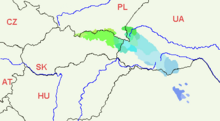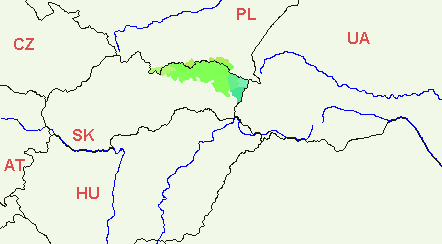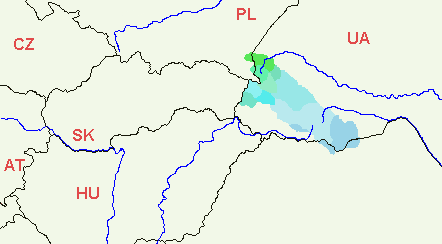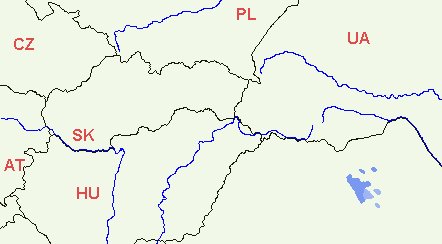Carpathian languages
| Carpathian languages | |
|---|---|
| Kārpāthirēta | |
| Created by | Raistas |
| Setting | parallel Earth |
| Native to | Slovakia, Ukraine, Poland, and Romania |
| Ethnicity | Carpathian people |
| Native speakers | 90000 (2001–2012) |
Oronaic
| |
Early form | Proto-Carpathian
|
| Official status | |
Official language in | Slovakia (Eastern Slovakia regions) |
Recognised minority language in | seven districts of Ukraine and several communes in Romania. |
Distribution of the Carpathian dialects:
West Carpathian (kārpāthirēta)
East Carpathian (kārpāhrõuta)
South Carpathian (čorulki) | |
The Carpathian languages is a group of closely related languages, spoken in the Carpathian mountains, mainly in Eastern Slovakia and Western Ukraine, but also in Romania. It is a branch of the Oronaic language family. The group is usually divided into three languages, spoken by no more than 90 000 people. These languages are called West Carpathian, East Carpathian and South Carpathian, each having one or more native names.
West and East Carpathian form a dialectal continuum and there is no distinct boundary between them. Transitional dialects between East and South Carpathian existed during the Middle Ages, became extinct with native population having switched to Romanian. Although these languages are similar, their standard varieties share a low degree of mutual intelligibility between each other. Since the 1990s several minority groups started seeking recognition as distinct languages rather than dialects of West or East Carpathian, but this topic is still being discussed and they are majorly considered dialects.
Classification
The Carpatian languages form a branch of the Oronaic language family. According to the traditional view, Carpathian is more closely related to Alpian than to Hirtic, forming the Alpathian language group (which was a language family before Hirtya was also included). Recently, however, this theory is given less support, since Alpian and Carpathian languages show very few common innovations, as well as Proto-Alpathian being reconstructed almost identical to Proto-Oronaic and is not as strongly supported as had been earlier assumed. Also lexical similarities may be explained due to a geographic proximity earlier on their history and possible contancts.
The Carpathian languages are divided into three dialectal groups, called West, East and South Carpathian. These languages are further divided into various subgroups of dialects. West and East Carpathian form dialect continuum in which the neighbouring dialects may be mutually intelligible, but speakers of two more widely separated dialects will not understand each other's speech. Such a variety of dialects seems to appear because of a relative isolation of the speakers from each other and not very intensive contacts between the respective speakers in the past, mostly due to geographical barriers between the respective speakers, but nowadays also because of political borders. Here is the list of all major Carpathian dialect groups:
West Carpathian
- †Äzeränci Carpathian, a dialect of West Carpathian or a separate language, extinct.
- Ränci Carpathian
- Šilli Carpathian (Standard, ~45 000 speakers)
- Orava Carpathian
- Prešov Carpathian
- Ēlke Carpathian
- Border West Carpathian dialects1
- The Border dialects of West and East Carpathian are almost identical to one another.
East Carpathian
- Halicia Carpathian
- Autavō
- Kyvavō
- Jīri Carpathian
- Border East Carpathian dialects1
- Aujīri
- Hullujīri
- Ettejīri
- Puohō Carpathian (Standard, ~30 000 speakers)
- Ettepuohō
- †Transitional East-South dialects, extinct
South Carpathian
- Bistĕrca Carpathian (Standard, ~15 000 speakers)
- Orodna and Lešu Carpathian
History
The Proto-Carpathian is believed to have formed near Polish-Slovak border between 2500 BC and 200 AD, after its split from hypothetical Proto-Alpathian. According to most linguists, the language comes from Polish lowlands in the basin of Vistula river. The language borrowed many words from old Indo-European languages that migrated into the same area around that time (probably even Proto-Indo-European itself or its western dialects if consider the earliest dates being correct) during early Proto-Carpathian stage. The second layer of loanwords come from early Slavic languages which started expanding westwards. Proto-Carpathian began splitting around the Xth-XIth centuries and can be reconstructed quite thoroughly in its late stage, while the grammar of earlier stages remains to a great extend unknown, despite modern languages being conservative.
Orthographies
Nowadays all Carpathian languages use Latin alphabets with various additional letters to represent their phonologies. East Carpathian used Cyrillic alphabet, made by Soviet Union scholars and some books (like primers for children) were published during 1950's until the use of a written language was banned by the Soviet government.
The most common diacritic above consonants is haček (like in the "č" character for [t͡ʃ] sound). Some dialects also use acute mark to denote palatalization ("ś" for [ɕ] - a palatalized counterpart of [s]). Traditionally long vowels were not marked. Modern writings use a macron diacritic for this purpose, such as "ā", "ī", or "ū". Additionally, while writing Puoho dialect "õ" is used to represent both short and long [ɤ] sound, as they are not phonemically distinct, but in dictionaries and textbooks "ȭ" represents [ɤː] when it appears in words. South Carpathian has no long vowels, but uses "ĕ" and "ă" for its reduced vowels [ɘ~ɜ] and [ə~ɐ] respectively. Also umlaut marks front vowels in South Carpathian, like "ö" for [œ] and "ü" for [y]. West Carpathian uses umlaut only for ä [æ].



